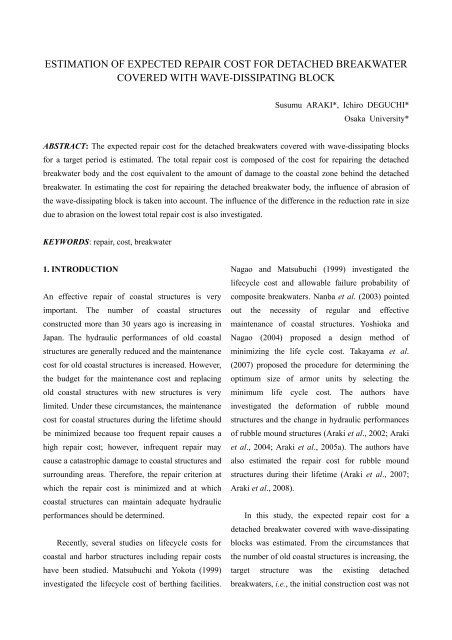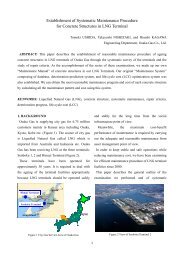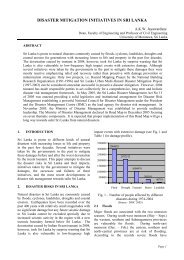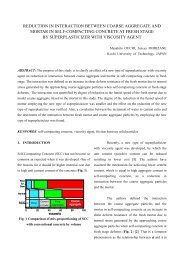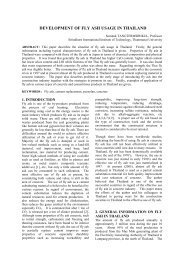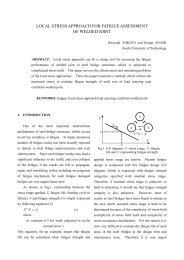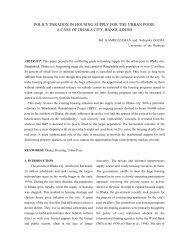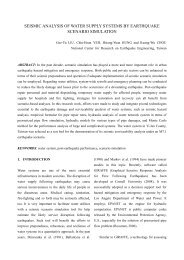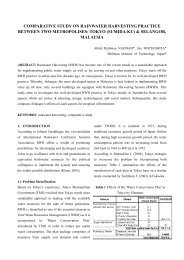estimation of expected repair cost for detached breakwater
estimation of expected repair cost for detached breakwater
estimation of expected repair cost for detached breakwater
Create successful ePaper yourself
Turn your PDF publications into a flip-book with our unique Google optimized e-Paper software.
ESTIMATION OF EXPECTED REPAIR COST FOR DETACHED BREAKWATER<br />
COVERED WITH WAVE-DISSIPATING BLOCK<br />
Susumu ARAKI*, Ichiro DEGUCHI*<br />
Osaka University*<br />
ABSTRACT: The <strong>expected</strong> <strong>repair</strong> <strong>cost</strong> <strong>for</strong> the <strong>detached</strong> <strong>breakwater</strong>s covered with wave-dissipating blocks<br />
<strong>for</strong> a target period is estimated. The total <strong>repair</strong> <strong>cost</strong> is composed <strong>of</strong> the <strong>cost</strong> <strong>for</strong> <strong>repair</strong>ing the <strong>detached</strong><br />
<strong>breakwater</strong> body and the <strong>cost</strong> equivalent to the amount <strong>of</strong> damage to the coastal zone behind the <strong>detached</strong><br />
<strong>breakwater</strong>. In estimating the <strong>cost</strong> <strong>for</strong> <strong>repair</strong>ing the <strong>detached</strong> <strong>breakwater</strong> body, the influence <strong>of</strong> abrasion <strong>of</strong><br />
the wave-dissipating block is taken into account. The influence <strong>of</strong> the difference in the reduction rate in size<br />
due to abrasion on the lowest total <strong>repair</strong> <strong>cost</strong> is also investigated.<br />
KEYWORDS: <strong>repair</strong>, <strong>cost</strong>, <strong>breakwater</strong><br />
1. INTRODUCTION<br />
An effective <strong>repair</strong> <strong>of</strong> coastal structures is very<br />
important. The number <strong>of</strong> coastal structures<br />
constructed more than 30 years ago is increasing in<br />
Japan. The hydraulic per<strong>for</strong>mances <strong>of</strong> old coastal<br />
structures are generally reduced and the maintenance<br />
<strong>cost</strong> <strong>for</strong> old coastal structures is increased. However,<br />
the budget <strong>for</strong> the maintenance <strong>cost</strong> and replacing<br />
old coastal structures with new structures is very<br />
limited. Under these circumstances, the maintenance<br />
<strong>cost</strong> <strong>for</strong> coastal structures during the lifetime should<br />
be minimized because too frequent <strong>repair</strong> causes a<br />
high <strong>repair</strong> <strong>cost</strong>; however, infrequent <strong>repair</strong> may<br />
cause a catastrophic damage to coastal structures and<br />
surrounding areas. There<strong>for</strong>e, the <strong>repair</strong> criterion at<br />
which the <strong>repair</strong> <strong>cost</strong> is minimized and at which<br />
coastal structures can maintain adequate hydraulic<br />
per<strong>for</strong>mances should be determined.<br />
Recently, several studies on lifecycle <strong>cost</strong>s <strong>for</strong><br />
coastal and harbor structures including <strong>repair</strong> <strong>cost</strong>s<br />
have been studied. Matsubuchi and Yokota (1999)<br />
investigated the lifecycle <strong>cost</strong> <strong>of</strong> berthing facilities.<br />
Nagao and Matsubuchi (1999) investigated the<br />
lifecycle <strong>cost</strong> and allowable failure probability <strong>of</strong><br />
composite <strong>breakwater</strong>s. Nanba et al. (2003) pointed<br />
out the necessity <strong>of</strong> regular and effective<br />
maintenance <strong>of</strong> coastal structures. Yoshioka and<br />
Nagao (2004) proposed a design method <strong>of</strong><br />
minimizing the life cycle <strong>cost</strong>. Takayama et al.<br />
(2007) proposed the procedure <strong>for</strong> determining the<br />
optimum size <strong>of</strong> armor units by selecting the<br />
minimum life cycle <strong>cost</strong>. The authors have<br />
investigated the de<strong>for</strong>mation <strong>of</strong> rubble mound<br />
structures and the change in hydraulic per<strong>for</strong>mances<br />
<strong>of</strong> rubble mound structures (Araki et al., 2002; Araki<br />
et al., 2004; Araki et al., 2005a). The authors have<br />
also estimated the <strong>repair</strong> <strong>cost</strong> <strong>for</strong> rubble mound<br />
structures during their lifetime (Araki et al., 2007;<br />
Araki et al., 2008).<br />
In this study, the <strong>expected</strong> <strong>repair</strong> <strong>cost</strong> <strong>for</strong> a<br />
<strong>detached</strong> <strong>breakwater</strong> covered with wave-dissipating<br />
blocks was estimated. From the circumstances that<br />
the number <strong>of</strong> old coastal structures is increasing, the<br />
target structure was the existing <strong>detached</strong><br />
<strong>breakwater</strong>s, i.e., the initial construction <strong>cost</strong> was not
included. In estimating the <strong>repair</strong> <strong>cost</strong>, the influence<br />
<strong>of</strong> abrasion <strong>of</strong> tetrapods on the de<strong>for</strong>mation in the<br />
<strong>detached</strong> <strong>breakwater</strong> body was taken into account.<br />
2. PROCEDURE FOR ESTIMATING OF<br />
EXPECTED REPAIR COST<br />
2.1 Overview<br />
Expected total <strong>repair</strong> <strong>cost</strong> was estimated by the<br />
model based on that proposed by Araki et al. (2007).<br />
The total <strong>repair</strong> <strong>cost</strong> was assumed to be composed <strong>of</strong><br />
the <strong>cost</strong> <strong>for</strong> <strong>repair</strong>ing the <strong>detached</strong> <strong>breakwater</strong> body<br />
and the <strong>cost</strong> equivalent to the amount <strong>of</strong> damage to<br />
the coastal zone behind the <strong>detached</strong> <strong>breakwater</strong>. The<br />
initial construction <strong>cost</strong> was not included in the total<br />
<strong>repair</strong> <strong>cost</strong> in this study because the <strong>repair</strong> <strong>cost</strong> <strong>for</strong><br />
the existing <strong>breakwater</strong>s was estimated. The<br />
procedure <strong>for</strong> estimating the <strong>expected</strong> <strong>repair</strong> <strong>cost</strong> is<br />
briefly summarized as follows:<br />
(i) The probability distribution <strong>of</strong> the incident<br />
wave height is determined by using the annual<br />
maximum wave height measured in the ocean.<br />
(ii) The annual maximum wave height <strong>of</strong> the<br />
incident wave is determined by generating a<br />
random number which satisfies the probability<br />
distribution.<br />
(iii) The magnitude <strong>of</strong> de<strong>for</strong>mation caused by the<br />
wave attack <strong>of</strong> the annual maximum incident<br />
wave is estimated.<br />
(iv) The transmitted wave height behind the<br />
de<strong>for</strong>med <strong>detached</strong> <strong>breakwater</strong> is estimated.<br />
(v) If the criteria <strong>for</strong> <strong>repair</strong>ing the <strong>detached</strong><br />
<strong>breakwater</strong> body are satisfied or if damage<br />
occurs to the coastal zone, the <strong>cost</strong> <strong>for</strong><br />
<strong>repair</strong>ing the <strong>detached</strong> <strong>breakwater</strong> or the <strong>cost</strong><br />
equivalent to the amount <strong>of</strong> damage to the<br />
coastal zone is estimated.<br />
(vi) The above procedure, from steps (i) to (v), is<br />
per<strong>for</strong>med annually. There<strong>for</strong>e, the steps are<br />
annually iterated until the end <strong>of</strong> a target<br />
period.<br />
(vii) The steps (i) to (vi) are iterated with different<br />
numbers (Monte Carlo Simulation).<br />
Figure 1 shows the flowchart <strong>of</strong> the procedure.<br />
The probability distribution <strong>of</strong> occurrence <strong>of</strong> the<br />
incident wave height in Step (i) was determined to be<br />
a Weibull distribution with parameters A=1.87,<br />
B=4.20 and k=2.0 from the measured wave height.<br />
H 1/3 : Incident Wave Height<br />
A e : Eroded Area<br />
H t : Transmitted Wave Height<br />
S : Damage Level (= A e / D 2 n )<br />
S c : Non-dimensional Allowable De<strong>for</strong>mation<br />
(Repair Criterion)<br />
C r : Cost <strong>for</strong> Repairing Breakwater Body<br />
H tdc : Transmitted Wave Height that<br />
Represents Threshold <strong>of</strong> Damage<br />
C d : Cost Equivalent to Amount <strong>of</strong> Damage<br />
: Total Repair Cost<br />
C t<br />
START<br />
Generation <strong>of</strong> Incident Wave<br />
Estimation <strong>of</strong> A e<br />
Estimation <strong>of</strong> H t<br />
S > S No<br />
c<br />
Yes<br />
Estimation <strong>of</strong> C r<br />
H No<br />
t > H tdc<br />
Yes<br />
Repair<br />
Estimation <strong>of</strong> C d<br />
End <strong>of</strong> Period <br />
Yes<br />
Annual Total Repair Cos t<br />
Iteration 10000 <br />
Yes<br />
Total Repair Cost Ct<br />
END<br />
Figure 1. Flowchart <strong>of</strong> procedure<br />
No<br />
No
2.2 Relationship between Incident Wave Height<br />
and De<strong>for</strong>mation <strong>of</strong> Breakwater<br />
In order to investigate the relationship between the<br />
incident wave height and the de<strong>for</strong>mation <strong>of</strong> the<br />
<strong>detached</strong> <strong>breakwater</strong> body, the equation <strong>for</strong><br />
estimating the stability <strong>of</strong> tetrapods on a 1:1.5 slope<br />
proposed by Van der Meer (1988) was used in this<br />
study.<br />
H<br />
1 3<br />
D<br />
n<br />
N<br />
<br />
3.75<br />
N<br />
0.5<br />
od<br />
0.25<br />
<br />
0.85<br />
s<br />
<br />
0.2<br />
om<br />
(1)<br />
where H 1/3 is the significant wave height in front <strong>of</strong><br />
the <strong>detached</strong> <strong>breakwater</strong>; D n , the nominal diameter<br />
<strong>of</strong> tetrapods; , relative density (= / w – 1, : the<br />
density <strong>of</strong> tetrapods, w : density <strong>of</strong> water); N od , the<br />
actual number <strong>of</strong> displaced tetrapods related to a<br />
width <strong>of</strong> one nominal diameter (The number <strong>of</strong><br />
locking tetrapods is not included); s om , the wave<br />
steepness (= 2H 1/3 / gT 2 m , T m : mean wave period, g:<br />
gravitational acceleration); N, the number <strong>of</strong> the<br />
incident waves.<br />
The de<strong>for</strong>mation <strong>of</strong> the <strong>detached</strong> <strong>breakwater</strong><br />
body, i.e., the eroded area A e , can be estimated by<br />
calculating the actual number <strong>of</strong> displaced tetrapods<br />
N od . The actual number <strong>of</strong> displaced tetrapods N od<br />
can be related to the damage level S (= A e / D 2 n , A e :<br />
the eroded area <strong>of</strong> the <strong>detached</strong> <strong>breakwater</strong> body in a<br />
cross-shore pr<strong>of</strong>ile). Van der Meer (1994) mentioned<br />
that the damage level S <strong>for</strong> <strong>breakwater</strong>s covered with<br />
concrete armor units was approximately twice as<br />
large as the actual number <strong>of</strong> displaced tetrapods N od .<br />
In estimating the damage level S, the porosity <strong>of</strong> the<br />
armor layer is taken into account. On the contrary, in<br />
estimating N od , the porosity <strong>of</strong> the armor layer is not<br />
taken into account.<br />
The actual number <strong>of</strong> displaced tetrapods N od<br />
was calculated by the following equation derived<br />
from Eq. (1).<br />
2<br />
0.5<br />
N H1<br />
3 0.2<br />
0.85<br />
2<br />
3.75<br />
<br />
som<br />
<br />
Dn<br />
<br />
N <br />
(2)<br />
od<br />
The damage level S and the eroded area A e were<br />
calculated as follows:<br />
S 2N od<br />
(3)<br />
A<br />
2<br />
e<br />
S D n<br />
(4)<br />
Concrete blocks, such as tetrapods, are abraded<br />
by wave action and so on. Uchida et al. (2004)<br />
conducted the exposure test <strong>of</strong> concrete blocks and<br />
showed that the reduction rate in size <strong>of</strong> the concrete<br />
block was 3% <strong>for</strong> 15 years. From this result, the<br />
nominal diameter <strong>of</strong> tetrapods was assumed to<br />
decrease by 0.2% every year in this study.<br />
2.3 Relationship between De<strong>for</strong>mation <strong>of</strong><br />
Breakwater and Transmitted Wave Height<br />
The relationship between the de<strong>for</strong>mation <strong>of</strong> the<br />
<strong>breakwater</strong> body and the transmitted wave height<br />
was estimated by experimental results conducted by<br />
Araki et al. (2008). In the experiment, the <strong>detached</strong><br />
<strong>breakwater</strong> had a 1:4/3 slope, the crest width <strong>of</strong><br />
0.24m, the crest height above the still water level <strong>of</strong><br />
0.05m and the depth at the toe <strong>of</strong> 0.25m. The<br />
<strong>detached</strong> <strong>breakwater</strong> was covered with wave<br />
dissipating blocks <strong>of</strong> 0.0145kg. Eq. (1) was proposed<br />
<strong>for</strong> the coastal structures covered with tetrapods with<br />
a 1:1.5 slope. However, Eq. (1) was used <strong>for</strong><br />
estimating the de<strong>for</strong>mation <strong>of</strong> the <strong>detached</strong><br />
<strong>breakwater</strong> because the difference between the<br />
stabilities <strong>of</strong> tetrapods on a 1:4/3 and a 1:1.5 slopes<br />
was assumed to be not so large.<br />
2.4 Cost <strong>for</strong> Repairing Breakwater Body<br />
The <strong>detached</strong> <strong>breakwater</strong> was assumed to be <strong>repair</strong>ed<br />
when the damage level S <strong>for</strong> the <strong>detached</strong> <strong>breakwater</strong><br />
exceeded the <strong>repair</strong> criterion. The many researches<br />
have reported that the increase in the damage level S
caused the increase in the transmitted wave height<br />
behind the <strong>breakwater</strong> (e.g., Araki et al. 2008).<br />
There<strong>for</strong>e, the increase in the damage level S means<br />
the reduction <strong>of</strong> the hydraulic per<strong>for</strong>mance <strong>of</strong> the<br />
<strong>detached</strong> <strong>breakwater</strong>.<br />
The <strong>cost</strong> <strong>for</strong> <strong>repair</strong>ing the <strong>breakwater</strong> body per<br />
unit length C r was assumed to be proportional to the<br />
eroded area in a cross-section <strong>of</strong> the <strong>detached</strong><br />
<strong>breakwater</strong>. The C r was estimated by the following<br />
equations.<br />
C<br />
r<br />
C A b C <strong>for</strong> S > S c (5)<br />
ru<br />
e<br />
r 0<br />
C 0<br />
<strong>for</strong> S < S c (6)<br />
r<br />
where S c is the non-dimensional allowable<br />
de<strong>for</strong>mation <strong>of</strong> the <strong>detached</strong> <strong>breakwater</strong>, i.e., the<br />
<strong>repair</strong> criterion; C ru , the <strong>cost</strong> <strong>for</strong> <strong>repair</strong>ing the<br />
<strong>detached</strong> <strong>breakwater</strong> body per unit volume <strong>of</strong> the<br />
<strong>breakwater</strong> body; b, the longshore distance <strong>of</strong> the<br />
eroded area (b=1.0m because <strong>of</strong> the two-dimensional<br />
investigation in this study); C r0 , the <strong>cost</strong> <strong>for</strong> <strong>repair</strong>ing<br />
the <strong>detached</strong> <strong>breakwater</strong> body independent <strong>of</strong> the<br />
volume <strong>of</strong> the eroded area.<br />
2.5 Cost Equivalent to Amount <strong>of</strong> Damage<br />
The <strong>cost</strong> equivalent to the amount <strong>of</strong> damage to the<br />
coastal zone behind the <strong>detached</strong> <strong>breakwater</strong> C d was<br />
assumed to be simply proportional to the transmitted<br />
wave height because it varies depending on the<br />
circumstances. The <strong>cost</strong> C d was estimated by the<br />
following equations.<br />
C<br />
d<br />
C<br />
da<br />
<br />
H<br />
t<br />
hc<br />
H<br />
tc<br />
hc<br />
<br />
Cdb<br />
<strong>for</strong> H t > H tdc (7)<br />
C 0<br />
<strong>for</strong> H t < H tdc (8)<br />
d<br />
where C da and C db are the constants that depend on<br />
the condition <strong>of</strong> land use in the coastal zone behind<br />
the <strong>detached</strong> <strong>breakwater</strong>; h c , the crest height above<br />
the still water level; H tdc , the transmitted wave height<br />
that represents the threshold <strong>of</strong> the damage to the<br />
coastal zone behind the <strong>detached</strong> <strong>breakwater</strong>.<br />
2.6 History <strong>of</strong> De<strong>for</strong>mation<br />
The <strong>detached</strong> <strong>breakwater</strong> is not <strong>repair</strong>ed if the<br />
per<strong>for</strong>mance <strong>of</strong> the <strong>detached</strong> <strong>breakwater</strong> is sufficient<br />
to maintain tranquility behind the <strong>detached</strong><br />
<strong>breakwater</strong>. There<strong>for</strong>e, the accumulation <strong>of</strong> the<br />
de<strong>for</strong>mation <strong>of</strong> the <strong>detached</strong> <strong>breakwater</strong> has to be<br />
taken into account. The number <strong>of</strong> the incident wave<br />
in the i-th year N’ which causes the de<strong>for</strong>mation<br />
equivalent to the actual number <strong>of</strong> displaced<br />
tetrapods in the (i–1)-th year N od,i–1 was calculated by<br />
the following equation derived from Eq. (1).<br />
<br />
<br />
4<br />
3.75 N<br />
od , i1<br />
N <br />
(9)<br />
4<br />
H1<br />
3 2 <br />
s 0.85<br />
<br />
om<br />
Dn<br />
<br />
Then, the actual number <strong>of</strong> displaced tetrapods<br />
in the i-th year N od,i was estimated by the following<br />
equation using the sum <strong>of</strong> N i and N’ (N i : the number<br />
<strong>of</strong> the incident wave in the i-th year).<br />
N<br />
od , i<br />
<br />
<br />
N<br />
i<br />
N <br />
3.75<br />
2<br />
<br />
H<br />
<br />
D<br />
1 3<br />
n<br />
0.5<br />
s<br />
2<br />
0.2<br />
om<br />
<br />
0.85<br />
<br />
2<br />
(10)<br />
The actual number <strong>of</strong> displaced tetrapods N od,i in<br />
the i-th year estimated by Eq. (10) includes the<br />
history <strong>of</strong> the de<strong>for</strong>mation caused be<strong>for</strong>e the i-th year.<br />
The eroded area A e in a cross-shore pr<strong>of</strong>ile was<br />
calculated from Eqs. (3) and (4).<br />
2.7 Total Repair Cost<br />
In a year, the sum <strong>of</strong> the <strong>cost</strong> <strong>for</strong> <strong>repair</strong>ing the<br />
<strong>breakwater</strong> body C r and the <strong>cost</strong> equivalent to the<br />
amount <strong>of</strong> damage to the coastal zone C d is the<br />
annual total <strong>repair</strong> <strong>cost</strong>. The sum <strong>of</strong> the annual total<br />
<strong>repair</strong> <strong>cost</strong>s over the target period is the total <strong>repair</strong><br />
<strong>cost</strong> C total . In summing up the annual total <strong>repair</strong><br />
<strong>cost</strong>s, the interest was taken into account. The initial<br />
construction <strong>cost</strong> was not included in the total <strong>repair</strong><br />
<strong>cost</strong> because the <strong>repair</strong> <strong>cost</strong> <strong>for</strong> the existing <strong>detached</strong>
eakwaters was investigated in this study.<br />
2.8 Assumptions and Conditions in Estimation<br />
The <strong>repair</strong> was assumed to be completed by the<br />
incidence <strong>of</strong> the maximum wave in the next year. In<br />
the <strong>repair</strong>, the pr<strong>of</strong>ile <strong>of</strong> the <strong>detached</strong> <strong>breakwater</strong> was<br />
restored to the initial configuration. The hydraulic<br />
per<strong>for</strong>mances <strong>of</strong> the <strong>repair</strong>ed <strong>detached</strong> <strong>breakwater</strong><br />
were assumed to be the same as that <strong>of</strong> the <strong>detached</strong><br />
<strong>breakwater</strong> just after the initial state.<br />
The number <strong>of</strong> the iteration in Monte Carlo<br />
simulation was 10,000. The interest used in the<br />
<strong>estimation</strong> <strong>of</strong> the total <strong>repair</strong> <strong>cost</strong> was 0.04. The<br />
duration <strong>of</strong> the incident N i wave was 4,000 waves.<br />
The constants <strong>for</strong> estimating the <strong>cost</strong> <strong>for</strong> <strong>repair</strong>ing<br />
the <strong>breakwater</strong> body were C ru = 14,000 JPY/m 3<br />
(JPY: Japanese Yen) and C r0 = 60,000 JPY/m 3 . The<br />
constants <strong>for</strong> estimating the <strong>cost</strong> equivalent to the<br />
amount <strong>of</strong> damage to the coastal zone behind the<br />
<strong>detached</strong> <strong>breakwater</strong> were C da = 8.25×10 7 JPY//m<br />
and C db = 7.8×10 6 JPY/m.<br />
3. RESULTS AND DISCUSSION<br />
3.1 Time Series in a Sample<br />
Figure 2 shows a sample under the condition <strong>of</strong> S c =<br />
32.0 and H tdc / h c = 0.32 <strong>for</strong> 30 years in Monte Carlo<br />
Simulation. Figure 2(a) shows the relationship<br />
between the annual maximum incident wave height<br />
and the damage level in the <strong>detached</strong> <strong>breakwater</strong><br />
body. The left vertical axis shows the annual<br />
maximum incident wave height and the right vertical<br />
axis shows the damage level S. Figure 2(b) shows<br />
the variations <strong>of</strong> the <strong>cost</strong> <strong>for</strong> <strong>repair</strong>ing the <strong>detached</strong><br />
<strong>breakwater</strong> body C r , the <strong>cost</strong> equivalent to the<br />
amount <strong>of</strong> damage to the coastal zone behind the<br />
<strong>detached</strong> <strong>breakwater</strong> C d and the total <strong>repair</strong> <strong>cost</strong> C total<br />
which is the sum <strong>of</strong> C r and C d in the same sample as<br />
Figure 2(a).<br />
(a) Annual maximum incident wave height and<br />
damage level in <strong>detached</strong> <strong>breakwater</strong> body<br />
Cost (10 3 JPY / m)<br />
Wave Height (m)<br />
14<br />
12<br />
10<br />
8<br />
6<br />
4<br />
2<br />
20000<br />
15000<br />
10000<br />
5000<br />
0<br />
0<br />
0<br />
0<br />
5<br />
5<br />
C r<br />
C d<br />
C total<br />
10<br />
10<br />
15<br />
year<br />
15<br />
year<br />
Wave Height<br />
Damage Level S<br />
Repair Repair Repair Repair Repair<br />
(b) Costs C r , C d and C total (JPY: Japanese Yen)<br />
Figure 2. Sample in Monte Carlo Simulation<br />
In this sample, the <strong>detached</strong> <strong>breakwater</strong> was<br />
gradually de<strong>for</strong>med almost every year and the<br />
cumulative damage level increased. As a result, the<br />
<strong>detached</strong> <strong>breakwater</strong> was <strong>repair</strong>ed in the 3rd, 7th,<br />
16th, 20th and 26th years because the cumulative<br />
damage level was larger than the allowable<br />
de<strong>for</strong>mation, i.e., the <strong>repair</strong> criterion. In the 16th and<br />
20th years, the damage to the coastal zone behind the<br />
<strong>detached</strong> <strong>breakwater</strong> was caused because the<br />
transmitted wave height was larger that the threshold<br />
<strong>of</strong> damage to the coastal zone.<br />
3.2 Estimated Expected Repair Cost<br />
Figure 3 shows the variations <strong>of</strong> the <strong>cost</strong> <strong>for</strong><br />
<strong>repair</strong>ing the <strong>detached</strong> <strong>breakwater</strong> body C r , the <strong>cost</strong><br />
equivalent to the amount <strong>of</strong> damage to the coastal<br />
20<br />
20<br />
25<br />
25<br />
0<br />
30<br />
30<br />
60<br />
50<br />
40<br />
30<br />
20<br />
10<br />
Damage Level S
zone behind the <strong>detached</strong> <strong>breakwater</strong> C d and the<br />
<strong>expected</strong> total <strong>repair</strong> <strong>cost</strong> C total under the condition <strong>of</strong><br />
the non-dimensional transmitted wave height that<br />
represents the threshold <strong>of</strong> damage to the coastal<br />
zone H tdc / h c = 0.32 <strong>for</strong> 30 years. The horizontal axis<br />
shows the allowable damage level S c in the <strong>detached</strong><br />
<strong>breakwater</strong> body, i.e., the allowable de<strong>for</strong>mation.<br />
In the range <strong>of</strong> S c < 11, the <strong>cost</strong> <strong>for</strong> <strong>repair</strong>ing the<br />
<strong>detached</strong> <strong>breakwater</strong> body C r is high because any<br />
de<strong>for</strong>mation in the <strong>detached</strong> <strong>breakwater</strong> body is<br />
<strong>repair</strong>ed immediately. On the contrary, the <strong>cost</strong><br />
equivalent to the amount <strong>of</strong> damage to the coastal<br />
zone C d is low because the transmitted wave height<br />
does not become large. In the range <strong>of</strong> S c > 11, the<br />
<strong>cost</strong> <strong>for</strong> <strong>repair</strong>ing the <strong>detached</strong> <strong>breakwater</strong> body C r<br />
decreases because a small de<strong>for</strong>mation which is less<br />
than the allowable de<strong>for</strong>mation is not <strong>repair</strong>ed. On<br />
the contrary, the <strong>cost</strong> equivalent to the amount <strong>of</strong><br />
damage to the coastal zone C d increases with the<br />
increase in the allowable de<strong>for</strong>mation. From these<br />
characteristics, the lowest total <strong>cost</strong> can be founded<br />
around S c = 24 in this condition.<br />
3.3 Influence <strong>of</strong> Reduction Rate in Size<br />
Figure 4 shows the influence <strong>of</strong> the reduction rate in<br />
size <strong>of</strong> tetrapods due to abrasion on the <strong>expected</strong><br />
total <strong>repair</strong> <strong>cost</strong>. The horizontal axis shows the<br />
allowable damage level S c in the <strong>detached</strong><br />
<strong>breakwater</strong> body. The reduction rate in size was set<br />
to be 0.2% in this study. However, the reduction rate<br />
in size ranged from 0% to 2.0% here. The rate <strong>of</strong><br />
2.0% is much larger than that reported by Uchida et<br />
al. (2004). However, wave-dissipating blocks<br />
sometimes chip or break by wave attack. If the effect<br />
<strong>of</strong> chips and breakage <strong>of</strong> wave-dissipating blocks is<br />
also included, the reduction rate in size will be larger.<br />
The <strong>expected</strong> total <strong>repair</strong> <strong>cost</strong> C total were estimated<br />
under the condition <strong>of</strong> H tdc / h c = 0.32 <strong>for</strong> 30 years.<br />
Cost (10 3 JPY / m)<br />
50000<br />
40000<br />
30000<br />
20000<br />
10000<br />
0<br />
0<br />
C r<br />
C d<br />
C total<br />
10 20 30 40<br />
S c (Allowable De<strong>for</strong>mation)<br />
Figure 3. Variation in estimated <strong>cost</strong><br />
C total<br />
(10 3 JPY / m)<br />
50000<br />
40000<br />
30000<br />
20000<br />
10000<br />
0<br />
0<br />
Reduction Rate in Size<br />
0.0% 1.0%<br />
0.2% 2.0%<br />
0.5%<br />
10 20 30 40<br />
S c (Allowable De<strong>for</strong>mation)<br />
Figure 4. Influence <strong>of</strong> reduction rate in size<br />
The reduction rate in size affected the <strong>expected</strong><br />
total <strong>repair</strong> <strong>cost</strong> in the range <strong>of</strong> larger S c more than<br />
that in the range <strong>of</strong> smaller S c . In other words, the<br />
differences between the <strong>expected</strong> total <strong>repair</strong> <strong>cost</strong>s<br />
C total <strong>for</strong> the reduction rates in size 0.0% and 2.0% in<br />
the range <strong>of</strong> larger S c is larger than that in the range<br />
<strong>of</strong> smaller S c . In the <strong>expected</strong> total <strong>repair</strong> <strong>cost</strong> C total<br />
<strong>for</strong> the reduction rate in size 2.0%, the <strong>cost</strong><br />
equivalent to the amount <strong>of</strong> damage to the coastal<br />
zone behind the <strong>detached</strong> <strong>breakwater</strong> C d increases at<br />
the smaller allowable de<strong>for</strong>mation S c . As a result, the<br />
allowable de<strong>for</strong>mation at which the <strong>expected</strong> total<br />
<strong>repair</strong> <strong>cost</strong> C total is the lowest <strong>for</strong> the reduction rate in<br />
size 2.0% is smaller than that <strong>for</strong> the reduction rate<br />
in size 0.0%. In addition, the difference between the<br />
<strong>expected</strong> total <strong>repair</strong> <strong>cost</strong> at S c = 0.0 and the lowest<br />
<strong>expected</strong> total <strong>repair</strong> <strong>cost</strong> around S c = 18 is small <strong>for</strong><br />
the reduction rate in size 2.0%. There<strong>for</strong>e, an earlier
epair after de<strong>for</strong>mation in the <strong>detached</strong> <strong>breakwater</strong><br />
body was relatively important <strong>for</strong> the reduction rate<br />
in size 2.0%.<br />
and Three-dimensional Experiments, Proceedings <strong>of</strong><br />
14th International Offshore and Polar Engineering<br />
Conference, pp. 636-642, 2004<br />
4. CONCLUDING REMARKS<br />
The <strong>expected</strong> total <strong>repair</strong> <strong>cost</strong> <strong>for</strong> the <strong>detached</strong><br />
<strong>breakwater</strong> covered with wave-dissipating blocks<br />
was estimated using Monte Carlo simulation. The<br />
total <strong>repair</strong> <strong>cost</strong> was assumed to be composed <strong>of</strong> the<br />
<strong>cost</strong> <strong>for</strong> <strong>repair</strong>ing the <strong>detached</strong> <strong>breakwater</strong> body and<br />
the <strong>cost</strong> equivalent to the amount <strong>of</strong> damage to the<br />
coastal zone behind the <strong>detached</strong> <strong>breakwater</strong>. In<br />
estimating the <strong>expected</strong> total <strong>repair</strong> <strong>cost</strong>, the<br />
influence <strong>of</strong> the reduction rate in size <strong>of</strong> the<br />
wave-dissipating block due to abrasion and so on<br />
was included. In the high reduction rate in size, i.e.,<br />
2.0%, an earlier <strong>repair</strong> after de<strong>for</strong>mation in the<br />
<strong>detached</strong> <strong>breakwater</strong> body was relatively important<br />
because the difference between the <strong>expected</strong> total<br />
<strong>repair</strong> <strong>cost</strong> at the allowable de<strong>for</strong>mation S c = 0.0 and<br />
the lowest <strong>expected</strong> total <strong>repair</strong> <strong>cost</strong> was small.<br />
The values <strong>of</strong> the parameters used in this study<br />
were based on the assumptions. The values <strong>of</strong> the<br />
parameters vary depending on the circumstances. If<br />
the different values <strong>of</strong> the parameters are used in the<br />
<strong>estimation</strong>, the characteristics <strong>of</strong> the estimated <strong>cost</strong>s<br />
will be changed.<br />
S. Araki, H. Niijima, H. Fumoto, H. Miyoshi and I.<br />
Deguchi, Change in Transmission Coefficient with<br />
De<strong>for</strong>mation <strong>of</strong> Submerged Breakwater, Proceedings<br />
<strong>of</strong> 15th Int’l Offshore and Polar Engineering<br />
Conference, ISOPE, pp. 606-611, 2005<br />
S. Araki, R. Tanaka, G. Urai and I. Deguchi,<br />
Estimation <strong>of</strong> Repair Cost and Optimum Repair Plan<br />
<strong>for</strong> Rubble Mound Breakwater, Proceedings <strong>of</strong> 5th<br />
Coastal Structures Int’l Conference, pp. 1830-1841,<br />
2007<br />
S. Araki, G. Urai, H. Makino, M. Arita and I.<br />
Deguchi, Optimum Repair Plan <strong>for</strong> Detached<br />
Breakwaters Including Influences <strong>of</strong> Wave Grouping<br />
Characteristics <strong>of</strong> Incident Waves, Poster<br />
Proceedings <strong>of</strong> the 31st Int’l Conference on Coastal<br />
Engineering, pp. 355-367, 2008<br />
S. Matsubuchi and H. Yokota, Life Cycle Cost<br />
Analysis <strong>of</strong> Berthing Facilities and Development <strong>of</strong><br />
a Decision Support System during their Maintenance<br />
Work, Report <strong>of</strong> the Port and Harbour Research<br />
Institute, Vol. 38, No. 2, pp. 423-473, 1999 (in<br />
Japanese)<br />
REFERENCES<br />
S. Araki, Y. Kotake, T. Kanazawa, A. Matsumura and<br />
I. Deguchi, Development <strong>of</strong> numerical simulation<br />
method <strong>for</strong> predicting de<strong>for</strong>mation <strong>of</strong> rubble mound<br />
seawall, Proceedings <strong>of</strong> 28th Int’l Conference on<br />
Coastal Engineering, ASCE, pp. 1485-1497, 2008<br />
S. Araki, T. Yanagihara, H. Niijima, H. Fumoto and I.<br />
Deguchi, Differences between De<strong>for</strong>mations in Two-<br />
T. Nagao and S. Matsubuchi, Studies on Life-cycle<br />
Cost and Allowable Failure Probability <strong>of</strong><br />
Breakwaters, Report <strong>of</strong> the Port and Harbour<br />
Research Institute, Vol. 38, No. 2, pp. 395-422, 1999<br />
(in Japanese)<br />
K. Nanba, H. Yokota, Y. Tachibana, K. Tanaka and K.<br />
Iwata, Introductory Estimation <strong>of</strong> “LCM” in Coast<br />
Prevention Institution, Proceedings <strong>of</strong> Coastal<br />
Engineering, JSCE, Vol. 50, pp. 916-920, 2003 (in
Japanese)<br />
T. Takayama, T. Yasuda, D. Tsujio and J. Inoue,<br />
Optimum design <strong>for</strong> armor units based on the<br />
minimum life cycle <strong>cost</strong>, Proceedings <strong>of</strong> the 5th<br />
Coastal Structures Int’l Conference, pp. 1854-1863,<br />
2007<br />
N. Uchida, K. Funemoto, T. Nagamatsu and K.<br />
Kotani, Atmospheric Exposure Test <strong>of</strong><br />
Flyash-hi-fluidity Concrete Coast Block,<br />
Proceedings <strong>of</strong> the 59th Japan Society <strong>of</strong> Civil<br />
Engineers, 5-464, pp. 925-926, 2004 (in Japanese)<br />
J. W. Van der Meer, Stability <strong>of</strong> Cubes, Tetrapods<br />
and Accropode, Proceedings <strong>of</strong> Breakwaters ’88,<br />
Eastbourne, pp. 59-68, 1988<br />
Van der Meer, J. W., 1994. Conceptual Design <strong>of</strong><br />
Rubble Mound Breakwaters, Advances in Coastal<br />
and Ocean Engineering, Elsevier, Vol. 1, pp.<br />
221-315.<br />
T. Yoshioka and T. Nagao, A Study on<br />
Life-cycle-<strong>cost</strong> Based Design Method <strong>for</strong> Caisson<br />
Type Breakwaters, Annual Journal <strong>of</strong> Coastal<br />
Engineering, JSCE, Vol. 51, pp. 871-875, 2004 (in<br />
Japanese)


